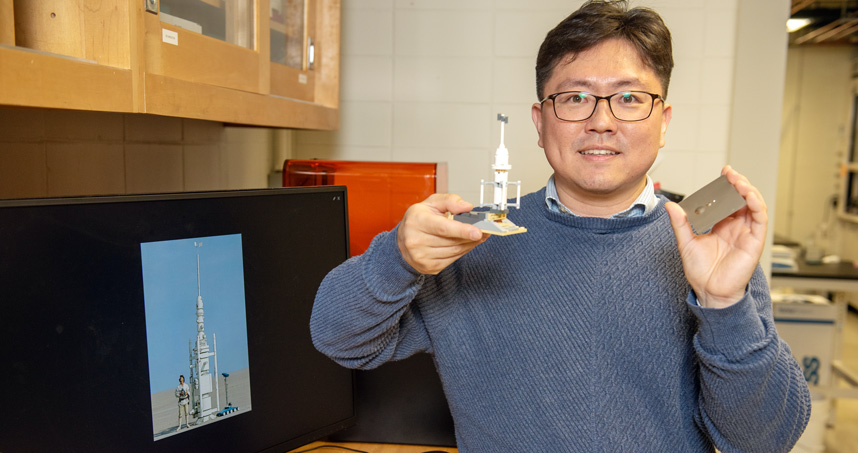May the Fog Be with You
Ken Park seeks to unlock the potential of fog, smog harvesting through bio-inspired surface engineering
As a self-professed fan of Star Wars, Northwestern Engineering’s Ken Park is all too happy to bridge his love of a galaxy far, far away to his research on the Evanston campus.
A close scan of items in his office hint at the connection: on his desk sits a Lego model of a moisture vaporator, the cylindrical water harvesting device famously seen in the beginning of the 1977 film.
“I always wondered how Luke Skywalker could run his family’s moisture farm on a desert planet like Tatooine, which I assumed had few sources of water,” said Park, assistant professor of mechanical engineering at the McCormick School of Engineering. “I later learned it was based on the idea of harvesting the moisture in the air.”
While Star Wars fans are familiar with the moisture vaporator’s cone-shaped humidity sensors and cooling vents, Park is more interested in how they work. Park is exploring how harvesting water from air — in the form of fog — using energy-efficient technologies could help tackle growing global concerns of water scarcity.
“So much attention is paid to humanity’s relationship with our planet, and water is essential to ensure both have a better future,” Park said. “Learning to harvest water more effectively is one way to do so.”
A bio-inspired approach to fog harvesting
Fog harvesters can be found throughout the world, from the mountains of South America to the desert coasts of Africa. Composed of mesh sheets stretched across two vertically aligned posts, these harvesters are an inexpensive and easy-to-maintain way to collect water. Yet they’re inefficient, with water droplets often escaping through the mesh if the holes are sized incorrectly.
Park and his lab take a bio-inspired surface engineering approach, looking to nature for clues for maximizing both the capture of fog and the drainage of water after its collected. This includes studying the optimal aerodynamic design of fog collectors, which recently led to new research providing guidelines on the best wire diameters and surface wettability for given wind speeds to maximize water collection efficiency.
“There are species of plants in the Namib Desert in Africa that demonstrate terrific fog collection ability using their vertically aligned, upright leaves,” said Park, a member of Northwestern’s Center for Water Research. “They look similar to the mesh wires in fog harvesters, which informed our approach to study single wires of different diameters against different wind speed conditions.”
Turning his attention to smog
Park also wants to apply his work to a new frontier — smog harvesting. With 4.2 million people dying each year from outdoor air pollution, according to the World Health Organization, extracting the smog in major cities could help tackle growing health and environmental challenges.
The issue lies in what Park refers to as “separation science.” Capturing smog is currently a far more difficult process than extracting water from fog, much like a vacuum cleaner is harder to use in humid places due to liquid in the air clogging filters.
“If we think of fog as airborne liquid droplets, smog is a combination of fog and smoke, which includes micro- and nanoparticles in the air,” he added. “We can capture fog and smog in similar ways, but the droplets in traditional fog filtration systems flow down by gravitational force. The particles present in smog don’t flow naturally.”
Park and his team are now exploring how to use smog harvesting technology to reduce the discharge of brine into the ocean by desalination plants, as well as recapturing water used in cooling towers of thermal power plants.
He hopes his innovations soon will lead to technology that’s more than just science fiction.
“I’ve always wanted to help solve a world problem,” Park said. “My research started with how to harvest fog water, but it has quickly evolved to possibly impacting energy and the environment.”

